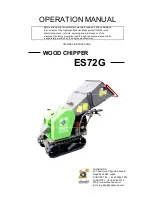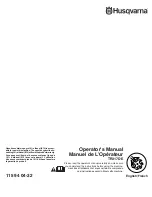
348
APPENDIX J — FACTORY-SUPPLIED PUMPS (cont)
Mechanical seals may weep slightly at start-up. Allow the
pump to continue operating for several hours and the mechani-
cal seal to seat properly prior to calling for service.
Seal Replacement (Fig. V)
Fig. V — Pump Seal Replacement
WIRING
If the pump motor is to be serviced on a bench, the motor wir-
ing must be disconnected.
ISOLATION VALVES
Close isolation valves on both sides of the pump assembly. Use
the drain plugs at the bottom of each manifold or the drain at
the bottom of the pump.
PREPARE FOR REMOVAL
Secure motor (1) with a lifting device. Motor and impeller as-
sembly weighs 65 lbs.
Disconnect the flush line from the pump suction and secure the
flex hose.
Remove the clamp ring between casing (4) and adapter (11).
REMOVE MOTOR
The rotating assembly (motor, adapter, and impeller) (1, 11, &
5) may now be lifted out of the casing.
The impeller (5) is fastened directly to the stub shaft and must
be removed to replace the mechanical seal assembly (8 and 9).
IMPELLER CAP SCREW
The impeller (5) should be prevented from rotating while the
impeller cap screw (6) is loosened. A heavy screwdriver or pry
bar may be inserted in between the impeller blades to enable
the impeller cap screw (6) to be backed off with a socket
wrench. Be careful not to damage the impeller blades. Remove
the impeller cap screw and washer (6 and 7).
PUMP IMPELLER
Using a wheel puller, with jaws behind the rear shroud of the
impeller, pull the impeller free of the pump shaft. Impeller hub
may be heated with a torch to aid in removal if required.
REMOVE MECHANICAL SEAL FROM MOTOR SHAFT
The mechanical seal spring usually comes free with the impel-
ler. The mechanical seal rotating element, seal head (9) must be
pried loose with pry bar or screwdrivers placed under each side
of the seal drive band. Leverage is applied against the adapter.
Once loosened, the seal may be pulled free of the shaft.
Do not damage the carbon face when removing the rotating el-
ement, seal head. It may be needed for analysis if seal failure
investigation is required.
REMOVE SEAL SEAT FROM ADAPTER
The stationary seat (8) typically Silicon Carbide material, is
pried loose from he recess in the adapter. If the seat cannot be
removed in the manner, remove the motor cap screws and
washer (2 and 3) and separate the adapter (11) from the motor
(1). A screwdriver may then be used to push the seat out of the
adapter from the rear.
REMOVE OLD CASING GASKET
The former adapter o-ring should be scraped from the adapter
leaving clean surfaces, groove, for the new o-ring.
REPLACE MECHANICAL SEAL
Clean the shaft stub (10) surface, ensuring all the former seal
elastomer pieces have been removed. Inspect for damage. Re-
place if necessary.
Install a new stationary seat (8) in the adapter cavity, being sure
the lapped, polished, side of the insert is facing up. Ensure that
the cavity has been thoroughly cleaned. Lubricate the station-
ary seat o-ring with a small amount of silicon or glycerin lubri-
cant and firmly press down straight and even into the adapter
cavity. Do not press the seat in with bare fingers or hammer.
Use a clean cloth or the cardboard disc typically supplied with
the seal packaging. Contamination on the polished and lapped
stationary seat face could cause leakage.
CAUTION
Do not use oil, Vaseline, or other petroleum or silicon base
products for seal elastomer lubrication. This may cause swell-
ing and failure of the seal.
CAUTION
Exercise extreme care when handling power wiring. Ensure
that fuses are removed or breaker disconnected in the power
supply to the motor. Power disconnect should be within line of
sight to the pump and tagged with reason for disconnection.
5
6
7
10
11
1
2
3
9
4
8
1
—
Motor
2
—
Motor Cap Screws
3
—
Washer
4
—
Casing
5
—
Impeller
6
—
Impeller Cap Screw
7
—
Washer
8
—
Stationary Seat
9
—
Seal Head
10
—
Shaft Stub
11
—
Adapter
CAUTION
Assure power is disconnected from evaporator/pump heaters
before draining pump assembly. Heaters will fail if energized
without water.
Summary of Contents for AquaForce 30XV140
Page 79: ...79 Fig 76 VFD Communication Wiring Compressor A B Fan VFD A1 A2 B1 B2...
Page 228: ...228 Fig 90 30XV Typical Field Wiring Schematic cont...
Page 229: ...229 Fig 91 30XV Standard Tier 140 275 All Voltages Power Schematic NOTE See Legend on page 226...
Page 230: ...230 Fig 92 30XV Standard Tier 300 325 All Voltages Power Schematic NOTE See Legend on page 226...
Page 240: ...240 Fig 99 30XV Communication Wiring...
Page 241: ...241 Fig 100 30XV 115V Control Wiring All Tonnages All Voltages...
Page 242: ...242 Fig 101 30XV 24V Control Wiring 30XV140 325 All Voltages...
Page 243: ...243 Fig 101 30XV 24V Control Wiring 30XV140 325 All Voltages cont...
Page 244: ...244 Fig 102 30XV 24V Control Wiring 30XV350 500 All Voltages...
Page 245: ...245 Fig 102 30XV 24V Control Wiring 30XV350 500 All Voltages cont...
Page 246: ...246 Fig 103 Component Arrangement Diagram for 30XV140 325...
Page 247: ...247 Fig 103 Component Arrangement Diagram for 30XV140 325 cont...
Page 248: ...248 Fig 104 Component Arrangement Diagram for 30XV350 500...
Page 337: ...337 APPENDIX J FACTORY SUPPLIED PUMPS cont Fig L System Information...
Page 338: ...338 APPENDIX J FACTORY SUPPLIED PUMPS cont Fig M Unit and Language Settings...
Page 341: ...341 APPENDIX J FACTORY SUPPLIED PUMPS cont Fig P Data Input 2...
Page 342: ...342 APPENDIX J FACTORY SUPPLIED PUMPS cont Fig Q Data Input 3...
Page 347: ...347 APPENDIX J FACTORY SUPPLIED PUMPS cont Fig U Pump Wiring Diagram...











































